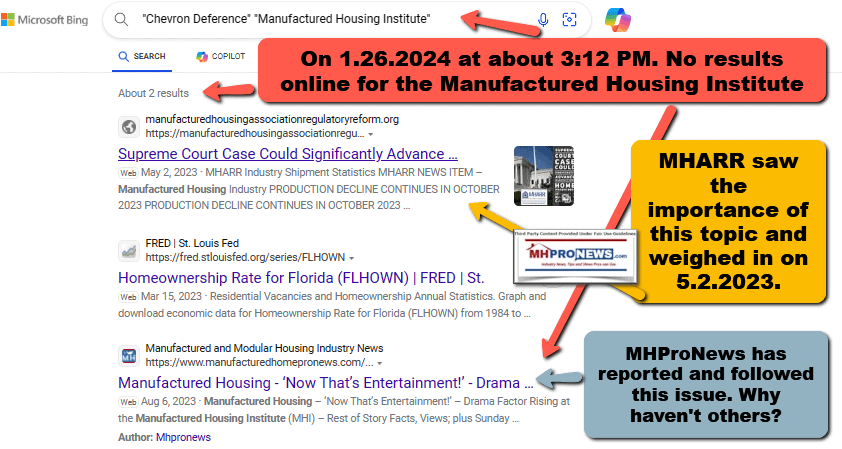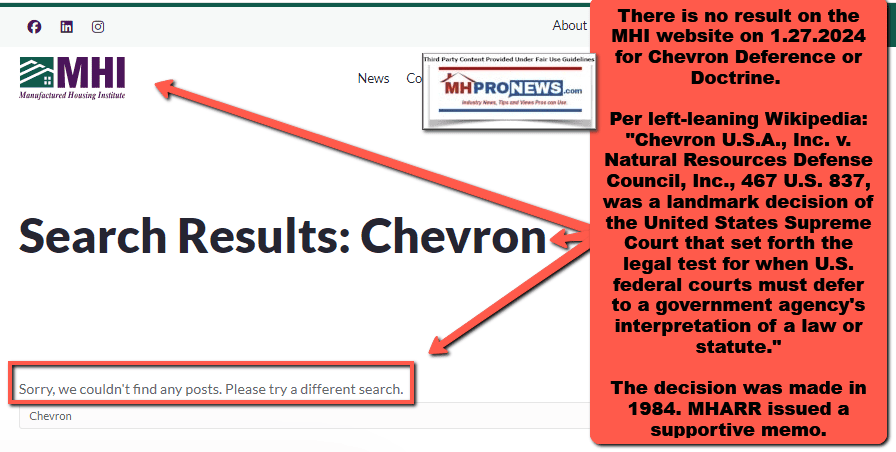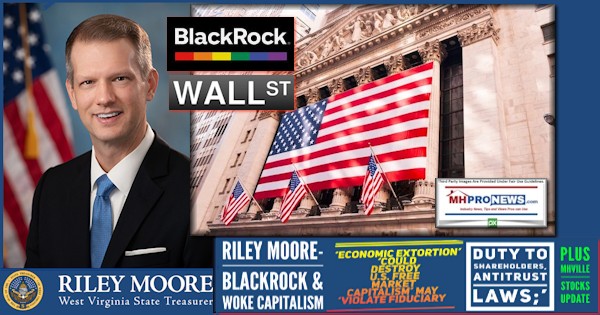
To frame the insights by David Harsanyi, a senior editor at The Federalist in its broader and manufactured housing industry specific context, consider the following. In May 2023, the Manufactured Housing Association for Regulatory Reform (MHARR) said: “The United States Supreme Court has accepted for review later this year, a case that could significantly alter the landscape of federal regulatory law, including critical matters that directly impact the comprehensively federally-regulated manufactured housing industry.” Harsanyi’s thoughts will follow.
MHARR’s memo to the industry continued by saying this.

For example, when HUD (in concert with its entrenched contractor) adopted current Subpart I procedures, including regulations, policy statements, “guidelines,” and other sub-regulatory criteria that have continually bedeviled industry production, MHARR – in the absence of Chevron deference – would, in 1985, have judicially challenged those actions. As MHARR members are aware, though, the Association chose not to proceed in that manner, because of the adoption of Chevron judicial deference just a year before.
If Chevron deference were overruled, however – or significantly limited — the likelihood of judicial relief concerning many regulatory issues affecting the industry would be enhanced, meaning that agencies would have to confront an increased likelihood of credible litigation over regulatory decisions and actions. This, in turn, would enable MHARR to more aggressively protect, defend and advance the views and interests of manufactured housing producers in Washington, D.C.”
With that context, Part I is a commentary by David Harsanyi, a senior editor at The Federalist from the WND News Center to MHProNews regarding the Chevron Deference. Part II will include the all the know published information on this topic by the Manufactured Housing Institute (MHI) as of the time shown below on 1.26.2024. Additional information with more analysis are included. Part III is our Daily Business News on MHProNews manufactured housing linked markets report and macro-market moving headlines recap across the left-right media divide.
Part I
SCOTUS
The administrative state is the real ‘threat to democracy’
David Harsanyi cheer for the fishermen in case before Supreme Court
By David Harsanyi
Published January 25, 2024 at 7:11pm
The government shows up at your business and demands you pay the salaries of the regulators who lord over you. If you refuse, you’ll be ruined. You have little recourse. You’ve never even voted on the policy because no law implementing it exists. Bureaucrats in D.C. cooked up the idea, and a political appointee signed off on it.
That’s what Loper Bright Enterprises v. Raimondo, a case brought by New England fishermen against Commerce Secretary Gina Raimondo, is all about. It may finally end or weaken Chevron deference, which refers to a 1984 decision that inadvertently empowered the administrative state to take wide-ranging, illiberal powers over American economic life.
I mean, the case of the fishermen is basically a modern reenactment of “taxation without representation.”
Yet when the Supreme Court took up oral arguments in Raimondo, the three leftist judges didn’t focus on the constitutionality of Chevron deference, but rather lamented the alleged problems of stripping government experts of their power. Here is how The Washington Post’s Ruth Marcus frames the arguments: “Who decides? From the liberal point of view: unelected judges or regulators with expertise and accountability? From the conservative vantage point: judges constitutionally empowered to say what the law is or unelected bureaucrats?”
It’s difficult to comprehend how any jurist who swore to uphold the Constitution could agree with the “liberal point of view.” Justices are “unelected” by design. It’s not a gotcha. It’s the point. And it is literally their job to “decide” the constitutionality of the laws and their implementation. Failing to do so is an abdication of their duty. Yet the contemporary Left treats SCOTUS as if it were some autocratic Star Chamber for doing its job.
Nowhere, on the other hand, does the Constitution say one word about unelected bureaucrats deciding the law. The executive branch, as the name strongly suggests, is tasked with executing laws as written. The Right initially cheered Chevron as a way to blunt judicial activism. But the allowances for “reasonable” decision-making when ambiguity exists in the law have been so abused that agencies like the Environmental Protection Agency will regulate every puddle and molecule of carbon dioxide.
Then again, the claim that regulators have unassailable “expertise” or real accountability is also a myth.
Democrats act as if they have a monopoly on apolitical, policy expertise. But there are almost always major disagreements over the efficacy and scope of regulatory policy, which is why politics exists, and why Democrats are keen on bypassing Congress and debate.
Moreover, the notion that government regulators are the best and brightest and attain their position through merit is complete bunkum, as anyone who’s paid more than five minutes of attention to the government already knows. This is especially true of political appointees, whose most valued skills are navigating bureaucracies and risk aversion.
Indeed, bureaucrats do not function under a notion of “accountability” that most normal people would recognize. When was the last time an agency cleaned house because its policies had failed? When was the last time the administrative state was reined back in any genuine way? How many regulators or appointees are ever fired? If you were as bad at your job as Alejandro Mayorkas, you’d be out of work forever.
That said, even if regulators were blessed with extraordinary work ethic, exceptionally creative minds and all the best ideas, they would still have zero right to create laws out of whole cloth.
Yet all the most vocal defenders of saving American “democracy” happen to think Chevron deference abuses are integral to governance. Read left-wing punditry on the topic and you might walk away with the impression that federal agencies didn’t even exist until 1984.
The histrionics over the potential death of Chevron deference is just another example of the Left’s abandonment of anything resembling a limiting principle. It’s all consequentialism, all the time. Anything Democrats dislike is an attack on “democracy.”
What Chevron deference does is incentivize Congress to write vague laws and presidents to abuse their power. It creates instability, as every administration implements its own preferred interpretation of the law. It threatens to further destroy the separation of powers. It was a huge mistake. And, as opposed to most of the Left’s hysterics these days, it’s a real threat to “democracy.”
David Harsanyi is a senior editor at The Federalist. Harsanyi is a nationally syndicated columnist and author of five books – the most recent, “Eurotrash: Why America Must Reject the Failed Ideas of a Dying Continent.” His work has appeared in National Review, the Wall Street Journal, Washington Post, Reason, New York Post and numerous other publications.
Part II – Additional Information with More MHProNews Analysis and Commentary
> “What has the Manufactured Housing Institute said about the Chevron Deference as it applies to Manufactured Housing? …”

The Manufactured Housing Institute (MHI) has not made any public statements regarding the Chevron Deference as it applies to manufactured housing 2. However, the Manufactured Housing Association for Regulatory Reform (MHARR) has been closely monitoring the case and has issued a statement regarding the potential impact of the case on the manufactured housing industry 1. According to MHARR, if the Chevron Deference were overruled or significantly limited, the likelihood of judicial relief concerning many regulatory issues affecting the industry would be enhanced, meaning that agencies would have to confront an increased likelihood of credible litigation over regulatory decisions and actions 1.
Regarding the specific article you mentioned, it discusses the Loper Bright Enterprises v. Raimondo case and its potential impact on the manufactured housing industry 1. The article does not mention any statements made by MHI regarding the Chevron Deference 1. …”
Copilot linked MHARR’s report here. Copilot also linked to articles on MHProNews, but didn’t provide any from any other trade media source in manufactured housing. The articles linked by Copilot are the two shown below.
As in several other issues raised in the analysis of Harvard’s 2024 exploration of why manufactured housing is underperforming in the 21st century, MHI has apparently been publicly silent on the Chevron Deference.
Meanwhile, others have weigh in. Among them is Judge Andrew Napolitano, who has a periodic column, including these pull quotes from the WND News Center. While Napolitano didn’t take on the tax issue in the same way that a popular and successful investor has in a report planned for Monday, the attorney and judge did say that remark on President Woodrow Wilson’s (D) “unconstitutional government by experts.” Editing out some rather controversial notions about President Abraham Lincoln (R) and skipping ahead to Napolitano’s thoughts on Chevron is the following.

…America from its founding to the early part of the 20th century more or less enjoyed the James Madison model for the federal government.
Under this model, the federal government could only legislate, regulate and spend in the 16 discrete areas of governance the Constitution delegated to it. All other areas of human behavior were left free to individual choices or governance by the states.
From and after Wilson’s presidency, the Madisonian model was replaced by the Wilsonian one. Under this model, the feds could legislate, regulate and spend in any areas of governance for which there was a national political will, except for those areas that are expressly prohibited to them by the Constitution.
It would take another generation before the courts fully caught up to this, during which they gradually permitted Congress basically to write any law, regulate any behavior, spend any money, tax any event and intrude upon any relationship so long as it did not confront an express constitutional prohibition.
The Constitution itself – which Madison designed both to establish the federal government and to limit it – has been a dismal failure as an instrument of limitation. Madison himself wrote that only a structure external to the Constitution could be relied upon to keep the federal government in its place.
He was referring to the power of the states to nullify acts of the federal government that the states determined were outside its constitutional authority.
He was also referring to the natural right that individuals and political subdivisions have to leave the government, called secession. Just as the 13 colonies seceded from Great Britain, just as five of the original 13 states threatened to secede until a Bill of Rights was ratified, Madison argued, individuals can reject the government, smaller subdivisions can leave larger ones, and states can leave the feds.
Without the threat of nullification and secession, there is no effective restraint on the feds.
Now back to Wilson. His governmental sins were many – World War I, the Espionage Act that punishes speech, the federal income tax, the popular election of U.S. senators, the Federal Reserve and his government by experts – the latter known today as the administrative state.
This last insidious structure is not in any branch of constitutional government. It writes rules, interprets them, enforces them and punishes its victims.
According to the late Justice Antonin Scalia, this is an unconstitutional delegation of Congress’ legislative powers to entities within the government who are not answerable to the voters. Administrative agency heads are appointed by the president and confirmed by the Senate. But the folks who write the rules are permanent bureaucrats who do not change, no matter who is in the White House.
Last week, much of this was argued in the Supreme Court.
Here is the backstory.
Two sets of commercial fishermen, one in New Jersey and the other in Rhode Island, objected to a federal regulation – written by the National Marine Fisheries Service, not by Congress – that regulates the amount of lobsters they can extract from the sea. The regulation required these fishermen to have a federal agent on all of their boats when at sea and to reimburse the federal government for the $700 daily salary of each agent.
The fishermen challenged these regulations in federal appellate courts. Why in appellate courts? Congress gave the administrative agencies an aura of correctness – even the Department of Justice doesn’t have this, thank God. Thus, challenged agency rulings are presumed correct, are not entitled to fact-finding hearings before federal judges, and go directly to appellate courts. There, the only issue is whether the administrative agency abused its discretion.
The fishermen did have factfinding hearings of sorts before administrative law judges. This anti-constitutional system has judges who have the same boss as the agency prosecutors – here, the secretary of commerce – making recommendations to the secretary. This is hardly the independent judiciary contemplated by the Fifth Amendment.
The 3rd Circuit Court of Appeals in Philadelphia and the 1st Circuit Court of Appeals in Boston each affirmed the rulings of the secretary, as based on the expertise of the Marine agency and the findings of the administrative law judges, and dismissed the fishermen’s appeals.
It is rare in the modern era for courts to interfere with an administrative agency because of a monstrosity called the Chevron Doctrine. This rubric tells courts that they must show deference to an administrative agency’s interpretations of its own rules, because its bureaucrats are – channeling Wilson – experts.
Both appellate courts followed Chevron. After reviewing the oral argument in the Supreme Court last week, it appears that the court is poised to reverse, to dump the Chevron Doctrine and to put the feds on an equal footing with those who challenge them in court.
All regulations interfere with personal liberty. When the government interferes with liberty, not only should there be no deference to the government; there should be a presumption that the government’s behavior is wrong, immoral, unconstitutional and unlawful.
Why? Because freedom is the default position. Government is the negation of freedom. Freedom is everyone’s personal natural birthright. The sovereignty of the person – made in the image and likeness of the Creator – can never be equal morally and legally to a gaggle of bureaucrats running an artificial monopoly of power in a geographic area, otherwise known as the government.
Either our rights are inalienable or they are not. If they are not, freedom is an illusion. If they are inalienable, under the Constitution the government must leave our freedoms alone.”
Presidents Madison vs. Wilson
While Napolitano’s thoughts on President Abraham Lincoln would be rejected by millions, his insights on controversial remarks on the “unconstitutional” nature of Wilson’s ‘government by experts’ is one that bears closer scrutiny. The first 10 amendments to the U.S. Constitution, sometimes referred to as the Bill of Rights,” include specifically enumerated rights that the Declaration of Independence said come from God the Creator and are not given by government. Because they are not given or granted by government, the reasoning of the founders was, they could not be arbitrarily taken away by government. Government was “bound by the chains of the Constitution,” said founding fathers and Declaration drafter Thomas Jefferson.
> “Founding father Thomas Jefferson said that Government should be bound by the chains of the constitution. George Washington said that Government is force. Please give the specific quotes and their source or context.”

- Thomas Jefferson: The quote “In questions of power, let no more be heard of confidence in man, but bind him down from mischief by the chains of the constitution” is attributed to Thomas Jefferson in a letter he wrote to William Jarvis on September 28, 1820 1. He was expressing his views on the role of the judiciary and the need to limit the power of the government by the constitution 2.
- George Washington: The quote “Government is not reason; it is not eloquent; it is force. Like fire, it is a dangerous servant and a fearful master” is often attributed to George Washington, but there is no evidence that he ever said or wrote it 3. The earliest known source of this quote is from a book published in 1889 by James Fenimore Cooper, who claimed to have heard it from an old soldier who served under Washington 4…”
It is an apparent contradiction to say that there is “no evidence” that Washington said “Government is not reason; it is not eloquent; it is force. Like fire, it is a dangerous servant and a fearful master,” when in the very next sentence the source for that remark is cited. It may be fair to say that the support for the famous remark attributed to George Washington is tenuous. But Washington was clearly in favor of limited government in the form of a republic. Washington and the founders rejected monarchy, dictatorships, pure democracy, and many other forms of government that they discussed and debated before settling on the U.S. Constitution and its first 10 Amendments (a.k.a. the Bill of Rights). Meaning, at a minimum, the remark broadly fits similar remarks and apparent beliefs expressed by Washington.
> “Didn’t George Washington, and the founders specifically added the Bill of Rights in order to underscore the limited nature of the power of the federal government? And didn’t Washington and the founders distrust big government and monarchial or dictatorial power? Isn’t that why they settled on a republic with a separation of powers that retained many rights for the states and for “We the People”? So, even though there may be tenous support for that quote attributed to Washington by James Fenimor Cooper, doesn’t it broadly fit with the thinking of George Washington and the founders about limiting the power of the federal government with specific constitutional restraints?”

- Yes, the Bill of Rights was added to the Constitution in order to underscore the limited nature of the power of the federal government. The Bill of Rights consists of the first 10 amendments to the Constitution, which spell out the rights and freedoms of the people and the states, as well as the limitations on the government’s authority 123. The Bill of Rights was proposed by the Anti-Federalists, who opposed the ratification of the Constitution because they feared it gave too much power to the federal government and endangered the rights of the states and the people 2. The Federalists, who supported the Constitution, agreed to add the Bill of Rights as a compromise to secure the ratification of the Constitution by the states 2.
- Yes, Washington and the founders distrusted big government and monarchial or dictatorial power. They had fought a war of independence against the British monarchy, which they considered oppressive and tyrannical. They wanted to establish a republican form of government, which they often compared to the ancient Roman republic 4. They also wanted to avoid the factionalism and corruption that had plagued the British political system 5. They believed that the best way to preserve the liberty and happiness of the people was to limit the power of the government and to divide it among different branches and levels 67.
- Yes, that is why they settled on a republic with a separation of powers that retained many rights for the states and for “We the People”. The Constitution established a federal system of government, in which the power is shared between the national and state governments 8. The Constitution also created a system of checks and balances, in which the legislative, executive, and judicial branches of the federal government have different functions and can limit each other’s power 6. The Constitution also declared that the people are the source of the government’s authority and that the government exists to protect their rights 6.
- It is debatable whether the quote attributed to Washington by James Fenimore Cooper broadly fits with the thinking of Washington and the founders about limiting the power of the federal government with specific constitutional restraints. On the one hand, the quote expresses a distrust of government and a preference for individual liberty, which are consistent with the views of Washington and the founders. On the other hand, the quote implies a negative and pessimistic view of government, which may not reflect the views of Washington and the founders, who also recognized the need and the benefits of a strong and effective government 9. …”
There are numerous controversies about the power of the federal government that have arisen over the years since the Constitution was ratified. Many Americans don’t realize that the current constitution was the second one in effect in the U.S., because the Articles of Confederation which was operating during the Revolutionary War against England was generally considered to have been too weak. During the course of the 20th century, the power of the federal government generally grew, due in part to what Judge Napolitano called the shift from the Madison model of government to a more Wilsonian one.
> “Describe the Madisonian model of the federal government as opposed to the Wilsonian model of the federal government.

- The Madisonian model is based on the ideas of James Madison, one of the Founding Fathers and the main author of the Constitution. The Madisonian model emphasizes the separation of powers, checks and balances, federalism, and limited government as the means to prevent tyranny and protect individual rights 12. The Madisonian model also favors a republic over a pure democracy, as Madison believed that a large and diverse nation would prevent the domination of factions and the tyranny of the majority 3.
- The Wilsonian model is based on the ideas of Woodrow Wilson, the 28th president of the United States and a leader of the Progressive movement. The Wilsonian model advocates for a more active and powerful role of the federal government in regulating the economy, promoting social welfare, and advancing democracy and human rights around the world 45. The Wilsonian model also supports a more direct and participatory form of democracy, as Wilson believed that the people should have more influence and control over the government and its policies 67. …”
Right or wrong, Wilson did advance several constitutional amendments. In a follow up, MHProNews pointed out that the 16th Amendment was ratified during Wilson’s term in office, and Copilot concurred as follows.

Prior to the Revenue Act of 1913, the federal income tax had been struck down by the Supreme Court in the case of Pollock v. Farmers’ Loan and Trust Company (1895) 4. The Court ruled that the income tax imposed by the Wilson-Gorman Tariff Act of 1894 was unconstitutional, because it violated the constitutional requirement that direct taxes be apportioned among the states according to population 4. The Court reasoned that the income tax was a direct tax, because it was levied on the source of income, rather than on its use or expenditure 4. The Court’s decision effectively nullified the first peacetime income tax in the United States, which had been enacted to reduce the tariff rates and the reliance on regressive taxes 45.
The income tax was revived in 1913, after the ratification of the Sixteenth Amendment, which gave Congress the power to levy an income tax without apportionment among the states 6. The amendment was proposed by Congress in 1909, as a response to the growing public demand for tax reform and the Progressive movement’s call for a more equitable distribution of wealth and income 67. The amendment was ratified by the states in less than four years, reflecting the widespread support for the income tax among the people and the states 67.”
> “There are sources that assert that the income tax was not properly ratified, because the various versions of the income tax passed by state legislatures did not precisely match. Shed light on that and shed light on the notion that those who backed the income tax pitched it as a tax on the rich and not as a tax on the poor or middle class.”

- The claim that the income tax was not properly ratified is based on the argument that some of the states that ratified the Sixteenth Amendment did not approve the exact wording of the amendment as proposed by Congress, or that some of the states that rejected the amendment were counted as ratifying it 12. This argument was popularized by a book called The Law That Never Was, published in 1985 by William J. Benson and Martin J. “Red” Beckman 3. However, this argument has been rejected by many courts, scholars, and historians, who have found that the ratification process was valid and that the minor variations in wording or punctuation did not affect the meaning or the intent of the amendment 124.
- The notion that those who backed the income tax pitched it as a tax on the rich and not as a tax on the poor or middle class is partly true. The supporters of the income tax argued that it would make the tax system more fair and progressive, by shifting the burden of funding the government from tariffs and excise taxes, which disproportionately affected the poor and the middle class, to income taxes, which targeted the wealthy and the corporations 567. The income tax was also seen as a way to balance the federal budget, reduce the national debt, and provide revenue for social programs 67. However, the income tax was not exclusively a tax on the rich, as it applied to all incomes above a certain threshold, which varied over time and by filing status 58. The income tax rates were also progressive, meaning that they increased with the level of income, but they were not as high or as steep as some of the proponents of the income tax had initially proposed 58.”
While Bing is correct in saying that Beckman’s arguments have “been rejected,” even Copilot’s response admits that the foundation of the issues raised by Beckman are founded in reality. Namely: “…the minor variations in wording or punctuation did not affect the meaning or the intent of the amendment 124.” With that in mind, the following was a follow up.
> “But isn’t it accurate to say that normally when a bill is ratified by Congress, or an amendment is ratified by the states, that those bills are supposed to be precisely the same? Don’t attorneys often make the point that punctuation and even minor variations in the phrasing of a law matters?”

- According to the web search results, the ratification process for constitutional amendments is detailed in Article V of the Constitution, which states that an amendment must be proposed by either two-thirds of both houses of Congress or by a national convention called by two-thirds of the state legislatures, and then ratified by either three-fourths of the state legislatures or by three-fourths of the state conventions 12. The ratification process for bills passed by Congress is not specified in the Constitution, but it generally involves the enrollment of the bill by the enrolling clerk of the House of Representatives, the signing of the enrolled bill by the presiding officers of both houses of Congress, and the presentation of the signed bill to the President for his approval or veto 3.
- The web search results also indicate that punctuation and phrasing are crucial for clarity and precision in legal writing, as they can affect the meaning and interpretation of laws and contracts 4567. There are many examples of cases where punctuation and phrasing have made a difference in the outcome of legal disputes, such as the famous case of Pollock v. Farmers’ Loan and Trust Company (1895), where the Supreme Court struck down the income tax based on the placement of a comma in the Constitution 46. Therefore, legal writers should follow the rules and conventions of punctuation and phrasing, and avoid ambiguity and inconsistency in their texts 57.”
> “What was the federal debt in 1913? What is the federal debt circa 1.25.2024?”

- According to the web search results, the federal debt in 1913 was $2.91 billion, which is equivalent to $74.84 billion in today’s terms 1. The federal debt increased significantly during the presidency of Woodrow Wilson, who funded the U.S. involvement in World War I by issuing new federal bonds 2.
- According to the web search results, the federal debt as of January 2024 was $33.99 trillion 3. The federal debt has been rising rapidly in recent years, due to the increased spending by President Biden and Congress on various programs, such as the COVID-19 relief packages, the infrastructure bill, and the Build Back Better plan 345. …”
> “The Federal Reserve was also established during the Wilson Administration. Give some background on that topic.”

- The Federal Reserve is the central banking system of the United States, which regulates the money supply, sets interest rates, supervises banks, and serves as a lender of last resort 123.
- The Federal Reserve was created by the Federal Reserve Act of 1913, which was signed into law by President Woodrow Wilson on December 23, 1913 145.
- The Federal Reserve Act was a response to the Panic of 1907, a financial crisis that exposed the weaknesses and inefficiencies of the existing banking system, which lacked a central authority and a flexible currency 124.
- The Federal Reserve Act established a Federal Reserve System, consisting of a Federal Reserve Board in Washington, D.C., and twelve regional Federal Reserve Banks across the country 125.
- The Federal Reserve Act also gave the Federal Reserve the power to issue Federal Reserve Notes, which became the national currency, and to create a nationwide check-clearing system 125.
- The Federal Reserve Act aimed to provide a more stable and efficient banking system, to prevent financial panics, and to promote economic growth and development 124. …”
Life in America Before and Since Woodrow Wilson
Per Copilot: “Therefore, 137 years have gone by from the Declaration of Independence to 1913.” Also per Copilot: “111 years have gone by since 1913 to today.”
- the federal debt in 1913 was $2.91 billion, which [in inflation adjusted dollars] is equivalent to $74.84 billion in today’s terms 1.
- Per the USDebtClock.org on 1.27.2024 at about 10:14 AM there is 34.115 trillion dollars in national debt. Note in the graphic (screen capture collage) below that the federal debt as a ratio of U.S. GDP has more than doubled since 1960. The federal debt as a ratio of GDP declined by 1980. But now it is more than double what it was in 1960 or 2000. Where has all that money gone?

There has never been a perfect point in time in U.S. history. The same is true for any country anywhere or at any time on earth. That said, many make the argument that life in America for generations has been better than perhaps any other nation on earth at any time in world history.
Look again at tall the rationalizations that went into the Wilsonian model of government and the various laws and amendments that went into effect. Other than women’s voting rights, much of what was pitched has arguably not lived up to its promises. While it was posted on Veteran’s Day, for reasons that ought to be obvious, the lessons from famous Marine General Smedley Bulter are as apt 365 days a year, and an extra day on leap years.

There is an evidence-based case to be made that if HUD began to enforce the “enhanced preemption” provision of the Manufactured Housing Improvement Act of 2000 (MHIA) were robustly enforced, that over a period of perhaps a decade, most of HUD could be phased out other than Federal Housing Administration’s (FHA) lending programs, the Office of Manufactured Housing Programs (OMHP), and perhaps their PD&R department. Tens of billions could be saved annually at HUD alone. But the flip side is that despite tens of billions in federal spending on housing programs, plus billions more by state or local governments, the U.S. housing crisis has worsened.
The lack of affordable housing has fueled more homelessness, per sources on the left and right. HUD admitted just weeks ago that homelessness in the U.S. has hit a record recorded high, despite more federal spending.

MHARR has made the case that the Chevron Deference, if properly modified or stricken, could yield benefits for manufactured housing. But MHI has oddly been silent on this topic.


Time and again, MHI postures and claims being on the side of “all segments” of manufactured housing. But when they are put under the microscope, and their claims are carefully examined, what emerges is a picture of a trade group that is working for the consolidation of the industry. By contrast, MHARR has consistently been fighting for the growth of the industry since its founding. See the reports linked below for more.







Part III – is our Daily Business News on MHProNews stock market recap which features our business-daily at-a-glance update of over 2 dozen manufactured housing industry stocks.
This segment of the Daily Business News on MHProNews is the recap of yesterday evening’s market report, so that investors can see at glance the type of topics may have influenced other investors. Thus, our format includes our signature left (CNN Business) and right (Newsmax) ‘market moving’ headlines.
The macro market move graphics below provide context and comparisons for those invested in or tracking manufactured housing connected equities. Meaning, you can see ‘at a glance’ how manufactured housing connected firms do compared to other segments of the broader equities market.
In minutes a day readers can get a good sense of significant or major events while keeping up with the trends that are impacting manufactured housing connected investing.
Reminder: several of the graphics on MHProNews can be opened into a larger size. For instance: click the image and follow the prompts in your browser or device to OPEN In a New Window. Then, in several browsers/devices you can click the image and increase the size. Use the ‘x out’ (close window) escape or back key to return.
Headlines from left-of-center CNN Business – from 1.26.2024
- It’s not just Taylor Swift: AI-generated porn is targeting women and kids all over the world
- Shoppers at a Safeway grocery store in Scottsdale, Arizona, on Wednesday, Jan. 3, 2024.
- There’s a lot of good news for Americans in the latest inflation report
- The NSA buys Americans’ internet data, newly released documents show
- Britain has walked away from negotiations with Canada over a post-Brexit trade deal because of disagreements over beef and cheese.
- UK pulls out of post-Brexit trade talks with Canada
- Regional bank stocks could be on the rocks again
- Donald Trump and George Conway
- The Never Trump movement might be in its last throes, but a news publication it birthed is booming
- China’s wild week in markets: Calm returns but big challenges remain
- People shop at a home improvement store in Brooklyn on January 25, 2024 in New York City. Economic data from the Commerce Department released today showed that U.S. economy expanded 3.1 percent in 2023, shaking off inflation fears and making the U.S. the fastest growing advanced economy in the world in 2023.
- Why the US economy is doing so much better than the rest of the world
- Tesla share plunge wipes out $80 billion in market value, after dour earnings call
- TKO Executive Chairman of the Board Vince McMahon is seen during a ceremony announcing Dwayne “The Rock” Johnson has joined the Board of Directors for TKO at New York Stock Exchange on January 23, 2024 in New York City.
- Vince McMahon accused of trafficking former WWE employee in new lawsuit
- GM’s self-driving car division is under investigation by DOJ and SEC after pedestrian dragging incident
- Government warns funeral homes to stop misleading bereaved customers about pricing
- News industry off to brutal 2024 start as mass layoffs devastate publishers, raising questions about the future of journalism
- Apple announces sweeping changes for apps in Europe, including allowing third-party app stores for the first time
- Extreme greed is back on Wall Street
- Explicit, AI-generated Taylor Swift images spread quickly on social media
- The 737 Max grounding will cost Alaska Airlines $150 million
- Many parents say they are still financially subsidizing their adult children
- Business Insider cuts 8% of staff, becoming latest news outlet to undergo layoffs
- Cornell donor demands president step down, citing ‘toxic’ diversity policies
- US economy grew at a shocking pace in the fourth quarter
- Before part of an Alaska Airlines plane blew off, Boeing had removed and adjusted it, reports say
- Robert Kraft is buying a Super Bowl ad to highlight the rise of antisemitism








































